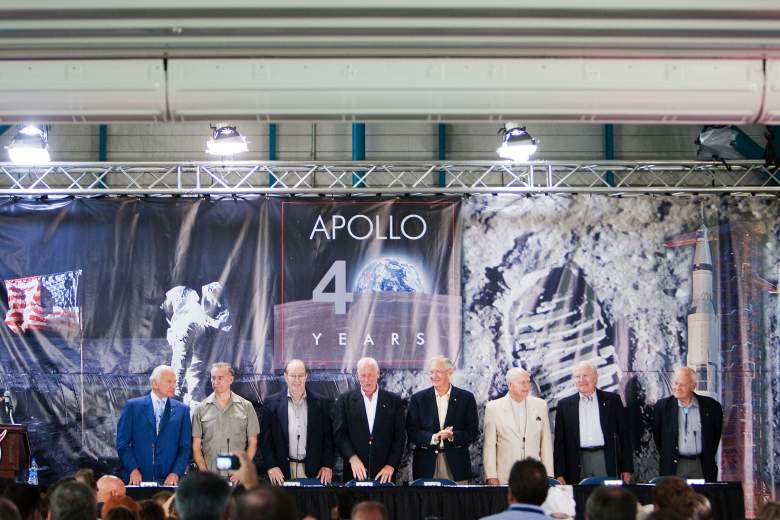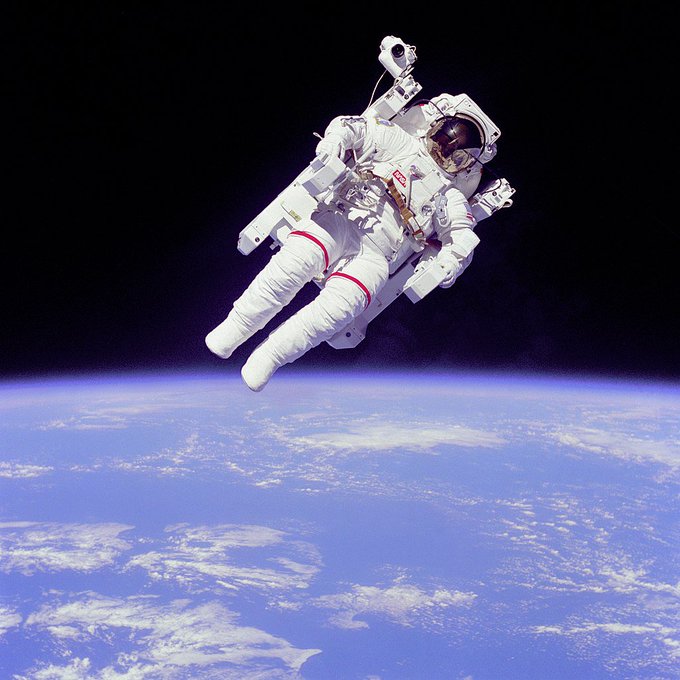
Getty Bruce McCandless, who made the first untethered spacewalk on this day in history, is pictured at far left.(L-R) Buzz Aldrin, Apollo 11 astronaut, Walt Cunningham, Apollo 7, Edgar Mitchell, Apollo 14, Al Worden, Apollo 15, Charlie Duke, Apollo 16, Jerry Carr, Apollo 8 & 12, Vance Brand, Apollo and Shuttle, and McCandless, Apollo and Shuttle, address the crowd gathered underneath a Saturn V rocket at the Kennedy Space Center Visitor Complex July 16, 2009 in Cape Canaveral, Florida.
Bruce McCandless marked this day in history with a daring move to venture from his space shuttle untethered to test new equipment on February 7, 1968. McCandless was a Houston native and contributed to his Texas community outside of NASA.
Also on this day in history, Stardust was launched to return the first comet samples from outside the moon’s orbit to Earth, according to NASA.
Follow the Heavy on Houston Facebook page for the latest Houston news and more.
Here’s what you need to know:
‘It May Have Been a Small Step for Neil, But It’s a Heck of a Big Leap For Me,’ McCandless Said Before His Space Walk
McCandless was a veteran astronaut who logged more than 312 hours in space, according to Chron, but it was his untethered space walk that etched his name in history.
He completed the untethered space walk to test the new Manned Maneuvering Unit (MMU) from the Challenger space shuttle, followed by fellow astronaut Bob Stewart, according to the Kennedy Space Center. McCandless, who also worked extensively on NASA projects and in mission control, had collaborated on the development of the MMU and tested it on Earth. Both astronauts ventured 300 feet from the space shuttle untethered. The 300-pound MMU was powered by 24 small compressed nitrogen thrusters and had two handles to control motion, the Kennedy Space Center wrote.
McCandless wrote in his 2015 memoir that he wanted to paraphrase Armstrong before his untethered space walk, but he gave it a humorous spin.
“My wife [Bernice] was at mission control, and there was quite a bit of apprehension,” he wrote. “I wanted to say something similar to Neil [Armstrong] when he landed on the moon, so I said, ‘It may have been a small step for Neil, but it’s a heck of a big leap for me.’ That loosened the tension a bit.”
He was a retired U.S. Navy captain who was selected to be one of NASA’s astronauts in 1966, according to his NASA bio. He served as mission specialist on two space missions, and also contributed to NASA on the ground, through both mission control and through his contributions to the development of the Hubble Space Telescope, the Space Station Program and other projects. He also served as the Mission Control communicator for Neil Armstrong and Buzz Aldrin’s moonwalk on the Apollo 11 mission, his NASA bio says.
McCandless, who died at age 80 in 2017, was originally from Houston and served in several organizations around Texas.
“Bruce McCandless III grew up in the shadow of Houston’s Johnson Space Center during the Apollo and Skylab eras, watching Batman and Buzz Aldrin with equal enthusiasm,” his biography says.
He served as a board member for the Houston Audubon, which remembered him for “his contributions to bird conservation in the Upper Texas Coast.”
Stardust, Launch in 1999, Changed What Scientists Believed About Comets With First Samples From Space
Scientists thought they had a basic understanding of comets, but that was before Stardust launched on February 7, 1999. The unmanned space mission lifted off from Cape Canaveral to meet up with the comet, Wild 2, and collect the first cometary samples from outside the moon’s orbit, according to Astronomy. It also made stops at asteroid Annefrank and comet Tempel 1 before its fuel supply was intentionally exhausted. It returned to Earth January 15, 2006, Astronomy reported.
“These particles were thought to be older than our solar system and contain remnants of the materials that built the solar system, but their true nature altered scientists’ understanding of how most of the rocky matter formed,” Astronomy reported.
Dr. Donald Brownlee, the principal investigator for Stardust, told Astronomy that the greatest thrill of the mission for him was presenting the first results of the sample analysis at the Lunar and Planetary Science Conference in League City, Texas.
“When I showed results to 600 people packed into the room, you could hear gasps and see jaws drop. We had gone to a type of body that is famed for its ices, a body whose dust was believed to be dominated by solids formed around other stars,” he told Astronomy. “We had found that it contained the highest temperature material that could ever have existed in the solar system. To find such material in a comet was revolutionary.”
READ NEXT: Today in Houston History: Challenger Explodes January 28, 1986

Comments
Today in Houston History: Bruce McCandless Goes on First Untethered Space Walk